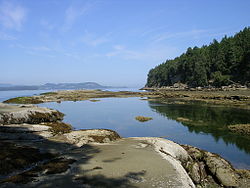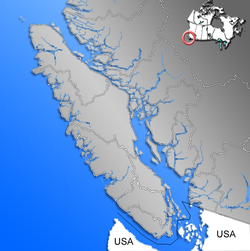Gabriola
| Gabriola Island | |
|---|---|
| Island | |

Beach at Descanso Bay
|
|
| Gabriola in the southern Gulf Islands | |
|
Location of Gabriola, near Vancouver Island
|
|
| Coordinates: 49°9′0″N 123°43′58.8″W / 49.15000°N 123.733000°W | |
| Country | Canada |
| Province | British Columbia |
| Regional District | Regional District of Nanaimo |
| Area | |
| • Total | 57.6 km2 (22.2 sq mi) |
| Population (2006) | |
| • Total | 4,050 |
| • Density | 70.3/km2 (182/sq mi) |
| Time zone | Pacific Time Zone (UTC−8) |
| • Summer (DST) | Pacific Daylight Time (UTC−7) |
| Postal code span | V0R |
| Area code(s) | 250 |
Gabriola Island is one of the Gulf Islands in the Strait of Georgia in British Columbia (BC), Canada. It is about 5 kilometres (3.1 mi) east of Nanaimo on Vancouver Island, to which it is linked by a 20-minute ferry service. It has a land area of about 57.6 square kilometres (22.2 sq mi) and a resident population of slightly over 4,000.
Gabriola has public beaches and forests, shopping centres, restaurants, a library, an elementary school and a museum. Its many cultural events include annual festivals related to art, poetry, gardens, music, boating and fishing. The Gabriola Arts Council hosts three large annual events: the Isle of the Arts Festival (April), Gabriola Theatre Festival (August) and Thanksgiving Studio Tour (October).
Gabriola is part of the traditional territory of the Snunéymux (of whose name the nearby city of Nanaimo was given an anglicized form). The earliest archeological record on Gabriola is a cave burial dated to about 1500 BCE.
The pre-contact population of Gabriola is difficult to estimate, but in mid-Marpole times—between about 0 and 1000 CE—several thousand people lived in the village at False Narrows, the site of today's El Verano Drive. Archaeologists have found that infant mortality at that time was surprisingly low and that the population was well adapted to its environment. Other smaller villages on Gabriola were scattered around the coast. After contact, and perhaps as early as 1500 CE, the population of the Snunéymux declined drastically from smallpox and other diseases brought to North America by Europeans.
The island is famous for its petroglyphs, which, while commonly believed to be thousands of years old, are almost impossible to date. Because they are carved in relatively soft sandstone, they are eroding rapidly.
The first European visit to Gabriola was by the Spanish schooner Santa Saturnina under José María Narváez in 1791. Narváez is said to have given the name Punta de Gaviola to the southeastern end of the island. It may also have been Juan Francisco de la Bodega y Quadra, rather than Narváez, who bestowed the name. Over time, "Gaviola" may have been corrupted into "Gabriola" and applied to the whole island. Gaviola is sometimes said to be a misspelling of gaviota ("seagull"), but it may refer to the Spanish surname Gaviola.
...
Wikipedia


